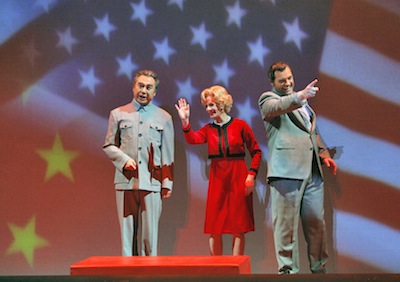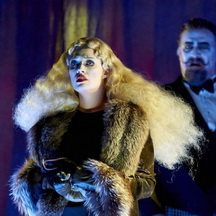
Flying into the past
Into the luminous mist of projected clouds weaves music that is both mysterious and compelling, a single rising scale from some exotic mode repeating softly, continuously. A distant plane appears suspended in the drifting white. It draws closer until the entire fuselage fills the front scrim, revealing the inscription: United States of America. A solitary light comes up on a man sitting at the airplane’s window. It is Richard Nixon looking down on the landscape of China.
Thus begins the San Francisco Opera production of “Nixon in China”, the 1987 opera by composer John Adams and librettist Alice Goodman, following a suggestion by Peter Sellars. The opera uses Nixon’s 1972 visit to China to examine the impact of global history on the men and women who create that history. These particular players—Nixon, Mao, Henry Kissinger and Chou En-lai—are less individualized men than figures who represent political thought in the late 20th century, despite Brian Mulligan’s use of the former President’s characteristic gestures and the make-up department’s rather exaggerated Nixonian nose.
The landing of Airforce 1 is greeted by a line of Maoist comrades dressed in drab khaki and dark blue. They sing: “Your master is the laborer/ Who rules the world with truth and grace/ Deal with him justly, face to face.”
It’s a credit to Alice Goodman that she can reanimate the most chillingly cliché ideas and political language into something numinous. The listener’s heart goes out to the sentiments buried within the rhetorical language. Even Nixon’s most hackneyed observations—and almost all of his language is cliché—take on the sheen of beauty.
Her job is eased by Adams’ intelligent and rich score. The repetitions of his minimalist-driven music invest the first act’s political speechifying with intensity and a sense of compulsive hesitation that suggests the blankness of thought behind the words.
Much has been made of the varieties of traditional operatic musical vocabulary that have used within “Nixon in China”—the arias, the ensemble pieces, the ballet. But what is more to the point, perhaps, is how different the opera is from the established opera that inhabits most houses year after year.
Defining the future
There is simply no plot to “Nixon in China”. Its three acts diminish in length and narrow in focus, their movement from the grand and historical to the intimate and personal, leaving a prism in the mind that crystallizes psychology rather than action.
The three scenes of the first act describe the political exchanges between Mao, Chou En-lai and Nixon. In the opera’s first brilliant aria, Nixon steps aside from the lines of introductions and handshaking to sing, “News. News has a kind of mystery.” This thrilled contemplation of history, its pervasive and transfiguring power over those who rule, settles slowly into a nostalgic vision of the American tendency to make the world its mission: “We have flown/ …Across an ocean of distrust/ … I know America is good/ At heart …”
In the act’s second scene, Mao presents his own disillusioned vision of the world: “The revolution does not last,/ … While it is young in us it lives;/ We can save it, it never saves.”
The second act focuses on the women in power: Pat Nixon and Madame Mao Tse-tung, Chiang Ch’ing. Presenting the rather homespun, good-hearted but somewhat delusional Pat in extreme contrast to the zealously scary Madame Mao. The focus of the act is the performance of the Cultural Revolution favorite, “The Red Detachment of Women”, a hybridized propaganda ballet. Dancers Chiharu Shibata and Bryan Ketron did a fantastic job of dancing the choreography of Wen Wei Wang, who adapted the original for this production.
The one-scene third act is half the length of the first act and is the only part of this in-every-way-splendid production that seems to misread the creators’ more interesting conception. Originally, the last act was set in the bedrooms of the players. It is post-event: the last night in Beijing. Everyone has discarded their formal clothes and roles: the act is a meditation on each individual’s past. In the current production the act is set in some abstract post-banquet hall setting. A kaleidoscope of players drifts through while the Nixons, Mao, Chiang Ch’ing, and Chou En-lai present their formative personal histories. There is simply too much going on during these intersecting moments of introspection.
Even so this is a terrific production. Gorgeous in its design with lots of red and waving flags by Erhard Rom (sets), Parvin Mirhady (costumes), Christopher Maravich (lighting) and Sean Nieuwenhuis (projections); Michael Cavanagh’s direction was seamless.
The singers are superlative. Brian Mulligan wields his lovely baritone to create a Nixon who is less offensive than adrift. Simon O’Neill as Mao has a searingly focused and intense tenor that inhabits the same Chinese opera world as uber-soprano Hye Jung Lee’s dazzling coloratura portrayal of Madame Mao. Maria Kanyova’s soprano imparts delicacy to the suffering Pat Nixon. Chen-Ye Yuan sang Chou En-lai in a stalwart and compassionate baritone. Patrick Carfizzi had the more thankless role to sing as a rather two-dimensional Henry Kissinger, professional letch. Mao’s back-up chorus, the Maoettes, was flawlessly sung by Ginger Costa-Jackson, Buffy Baggott and Nicole Birkland.
Integral to the success of this production were the wonderful San Francisco Opera Symphony and Chorus. Lawrence Renes conducted with brilliance, leading the orchestra to emphasize the score’s repetitive motives with clarity and rhythmic solidity while allowing the lushness of the underlying music to bloom forth. The voices were miked, in accordance with Adams’ wishes, but the amplification was subtle, allowing the singers to negotiate some very difficult passages without strain while blending with the orchestra.
Go see this opera!
—Jaime Robles
San Francisco Opera’s production of John Adams and Alice Goodman’s “Nixon in China” continues through July 3. Sung in English with English supertitles.
War Memorial Opera House, 301 Van Ness Ave., San Francisco. www.sfopera.org. 415-864-3330.
Photo: Chen-Ye Yuan (Chou En-lai), Maria Kanyova (Pat Nixon) and Brian Mulligan (Richard Nixon) in San Francisco Opera’s production of John Adams’ “Nixon in China”. Photo by Cory Weaver.
